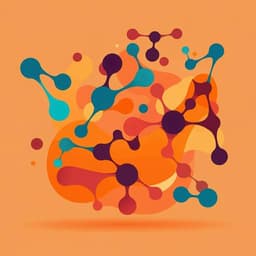
Psychology
Elevated rates of autism, other neurodevelopmental and psychiatric diagnoses, and autistic traits in transgender and gender-diverse individuals
V. Warrier, D. M. Greenberg, et al.
This groundbreaking study conducted by Varun Warrier and colleagues reveals that transgender and gender-diverse individuals experience significantly higher rates of autism diagnoses and autistic traits compared to their cisgender counterparts. With extensive data from over 641,000 participants, the research highlights critical mental health needs within this community.
~3 min • Beginner • English
Introduction
Autism is a neurodevelopmental condition affecting about 1–2% of the population, characterized by social-communication differences, restricted and repetitive behaviors, and atypical sensory sensitivity. Gender identity differs from sex assigned at birth; transgender and gender-diverse (TGD) identities are estimated at about 0.4–1.3% of the population, though estimates vary by definitions. Prior research, largely clinic-based and modest in size, suggests increased gender diversity among autistic individuals and increased autism diagnoses and autistic traits among people with gender dysphoria or gender diversity. However, effect sizes may be biased and generalizability is limited, particularly as many studies focus on gender dysphoria clinic samples rather than the broader TGD population. There is also evidence of higher mental health burdens among TGD individuals compared to cisgender individuals, but limited work comparing autism with other neurodevelopmental and psychiatric diagnoses. This study aims to clarify, in large, independently recruited datasets not designed specifically around gender identity, whether TGD individuals have: (1) elevated rates of autism diagnoses; (2) elevated autistic traits, systemizing, sensory sensitivity and reduced empathy; and (3) elevated rates of other neurodevelopmental and psychiatric conditions common in autism (ADHD, depression, bipolar disorder, OCD, learning disorder, schizophrenia). An exploratory question investigates whether TGD individuals are more likely to suspect undiagnosed autism.
Literature Review
Existing literature is heterogeneous across methods, ages, and countries. Studies using caregiver-report (e.g., CBCL) suggest 4–5.4% of autistic children may be TGD versus 0.7% of non-autistic children, with relative rates around 5.7–7.7. Large pediatric samples report a roughly fourfold likelihood of gender dysphoria diagnoses in autistic versus non-autistic children. Conversely, studies of gender dysphoria clinic attendees report 4.8–26% meeting criteria for autism, with large adult clinic samples at approximately 4.8–6.0%. Multiple studies also report elevated autistic traits in gender-diverse individuals compared to cisgender peers. The literature on mental health in TGD populations shows higher rates of depression, anxiety, substance use, and other psychiatric conditions relative to cisgender populations. However, few studies compare autism with a broad set of other conditions in TGD populations, and large non-clinic-based assessments are rare. There is also concern about under- or mis-diagnosis of autism in cisgender females; whether similar under-recognition occurs in TGD individuals remains unclear.
Methodology
Design: Cross-sectional analyses using five independently recruited datasets (four internet-based cross-sectional datasets and one longitudinal cohort subset), total N=641,860. None were recruited specifically to study gender identity and autism.
Datasets and recruitment:
- Channel 4 (C4): N=514,100; UK-based online questionnaires via a Channel 4 program about autism (2017). Gender option initially Male, Female, Transgender, Prefer not to say; later Transgender changed to Other. This study used the phase with Male, Female, Transgender only. Age 15–90 included. Autism and six other diagnoses self-reported as formally diagnosed. Participants completed AQ-10, EQ-10, SQ-10, SPQ-10.
- Musical Universe (MU): N=85,670; global convenience sample via musicaluniverse.org; duplicates removed via IP and demographics. Gender question labeled Sex with options Male, Female, Transgender, Other (treated as gender identity). Autism diagnosis and five other psychiatric conditions self-reported as formal diagnoses. Subset (N=54,127) provided comorbidity data.
- Autism Physical Health Survey (APHS): N=2,312; recruited via CARD, charities, social media. Anonymous online survey; duplicates excluded by detailed matching. Sex assigned at birth and current gender identity both recorded. Autism diagnosis details collected (clinician type, timing). TGD group included those with discordant sex assigned at birth and current gender identity; total TGD N=162.
- IMAGE: N=1,803; combined autism case-control (N=292) and mathematics cohort; recruited via databases, universities, societies, and social media. Sex at birth and gender collected with multiple categories; TGD group N=62. Autism diagnoses required professional diagnosis with verification by diagnostic report. All completed AQ-50. Subset provided education and answered suspected undiagnosed autism (yes/no).
- LifeLines: Netherlands population cohort subset, N=37,975; older sample; invited via general practitioners; individuals with severe mental health conditions not invited at baseline. Collected a combined sex-at-birth + gender identity item, creating cis male, cis female, trans men, trans women, and other identities (TGD total N=53). Autism diagnosis self-reported; AQ-10 completed.
Measures:
- Diagnoses: Autism and, where available, ADHD, bipolar disorder, depression, OCD, learning disorder (LD; C4 only), schizophrenia; all as self-reported formal diagnoses.
- Autistic trait measures: C4 (AQ-10, EQ-10, SQ-10, SPQ-10); IMAGE (AQ-50); LifeLines (AQ-10). Brain Types derived in C4 from standardized discrepancy between SQ-10 and EQ-10 (Extreme Type E, Type E, Type B, Type S, Extreme Type S).
Statistical analyses:
- Primary analyses: Compare autism diagnosis rates by gender category using chi-square tests (Model 1) and logistic regression adjusted for age and educational attainment (Model 2). IMAGE additionally adjusted for study group (mathematics vs case-control). Analyses conducted with three gender categories and then TGD vs cisgender combined.
- Sensitivity analyses: In MU, separate Transgender vs Other; also tested whether autism diagnosis predicts higher odds of TGD identity (logistic regression adjusting for age and education).
- Cross-dataset comparability: Subsampling bootstrap (10,000 subsamples) from C4 and MU to match sample sizes and composition of smaller datasets (IMAGE, APHS, LifeLines) to assess OR comparability and winner’s curse; Bonferroni-corrected empirical p-values.
- Traits analyses: ANOVA and post-hoc t-tests for AQ-10, EQ-10, SQ-10, SPQ-10 by gender within autistic and non-autistic strata in C4; linear regressions adjusting for age, education, and autism diagnosis; validation in IMAGE (AQ-50) and LifeLines (AQ-10). Brain Types distributions compared via chi-square.
- Other conditions: In C4 and MU, chi-square and adjusted logistic regressions for ADHD, bipolar disorder, depression, OCD, LD (C4 only), schizophrenia by gender. Repeated excluding autistic participants (Model 3) to assess autism-based ascertainment bias.
- Multivariable models: Multiple regression with TGD vs cisgender as dependent variable and all available diagnoses as predictors, adjusting for age and education, to compare relative association strengths.
- Exploratory analysis: In IMAGE, chi-square and ORs for suspected undiagnosed autism by gender.
- Multiple testing correction: Study-wide alpha p=0.0002 across at least 182 tests. Power analysis indicated LifeLines underpowered for some tests (power ~0.62–0.69 at alpha 0.05).
Ethics: Approvals obtained; informed consent across datasets; data sharing restrictions noted; analyses in R 3.4.4; code available on GitHub.
Key Findings
Autism diagnosis rates in TGD vs cisgender:
- C4: Significant gender differences in autism diagnosis. Unadjusted ORs for TGD vs cisgender: vs cis males OR 4.21 (95% CI 3.85–4.60), vs cis females OR 6.80 (6.22–7.42), vs all cis OR 5.53 (5.06–6.04), all p<2×10^-16. Adjusted for age and education: vs cis males OR 3.88 (3.54–4.25), vs cis females OR 5.31 (4.85–5.82), vs all cis OR 4.59 (4.20–5.03), all p<2×10^-16.
- MU, IMAGE, APHS, LifeLines: Chi-square significant in all datasets. Adjusted ORs (TGD vs cisgender): MU 6.07 (95% CI 4.56–8.08, p<2×10^-16), IMAGE 6.36 (3.34–12.13, p=1.08×10^-9), APHS 6.28 (4.13–9.53, p<2×10^-16), LifeLines 3.03 (0.72–12.76, p=0.13; concordant direction but underpowered). Bootstrap comparisons showed no significant differences between smaller datasets and subsamples from C4/MU.
- Autism predicting TGD identity (adjusted): C4 OR 4.66 (4.26–5.10, p<2×10^-16), MU 6.05 (4.55–8.05, p<2×10^-16), IMAGE 6.35 (3.32–12.11, p=2.1×10^-8), APHS 6.31 (4.14–9.62, p<2×10^-16); LifeLines OR 2.91 (0.69–12.20, p=0.14).
Autistic traits, systemizing, empathy, sensory sensitivity:
- Within TGD group, autistic individuals scored higher on AQ-10, SQ-10, SPQ-10 and lower on EQ-10 than non-autistic TGD (Cohen’s d 0.54–0.72, p<2×10^-16).
- In C4, both autistic and non-autistic TGD individuals scored higher than cis males and cis females on AQ-10, SQ-10, SPQ-10 and lower on EQ-10 (ANOVA p<2×10^-16; post-hoc t-tests significant). Effect sizes for TGD vs cis comparisons were larger than cis male vs cis female comparisons. Effect sizes larger in autistic (d 0.55–1.05) than non-autistic (d 0.32–0.96) strata.
- Adjusted betas (TGD vs cis) in C4: AQ-10 vs cis males Beta 0.89±0.02; vs cis females 1.05±0.02; SQ-10 vs cis males 0.66±0.02; vs cis females 0.99±0.02; SPQ-10 vs cis males 0.66±0.02; vs cis females 0.55±0.02; EQ-10 vs cis males −0.33±0.02; vs cis females −0.70±0.02; all p<2×10^-16.
- Validation: IMAGE AQ-50 higher in TGD vs cis males Beta 0.45±0.11 (p=3.09×10^-5) and vs cis females 0.52±0.11 (p<1.80×10^-6). LifeLines AQ-10 higher vs cis females Beta 1.23±0.25 (p=1.4×10^-6) and nominal vs cis males 0.51±0.25 (p=0.045).
- Brain Types (C4): Among non-autistic, TGD more often Type S (53%) and Extreme Type S (13.15%) than cis males (40.23%, 4.14%) and cis females (25.58%, 1.69%) (p<2×10^-16). Among autistic, TGD had Extreme Type S 34.73% and Type S 51.79% vs cis males 11.42%, 50.97% and cis females 7.55%, 42.29% (p<2×10^-16). Overall, 86.52% of autistic TGD were Type S or Extreme Type S vs 62.39% of autistic cis males.
Other neurodevelopmental and psychiatric conditions:
- C4: TGD had elevated rates of ADHD, bipolar disorder, depression, OCD, LD, and schizophrenia compared to cisgender. Unadjusted ORs ranged from 3.48 (LD; 95% CI 3.09–3.91) to 28.52 (schizophrenia; 24.17–33.66), all p<2×10^-16. Adjusted ORs modestly attenuated (e.g., LD ~3.08; schizophrenia ~19.73). Excluding autistic individuals (Model 3) further attenuated ORs (e.g., LD 1.92; schizophrenia 6.39). ORs for autism, ADHD, bipolar disorder, and depression were similar; OCD and LD about half the autism OR.
- MU: TGD had higher rates of all five available conditions (no LD). Unadjusted ORs ~2.15 (schizophrenia; not always significant) to 3.83 (depression). Adjusted results similar; after excluding autistic participants, depression remained elevated (up to OR ~3.91), schizophrenia ~1.11.
- Multivariable models: In C4, depression had the highest association with TGD (OR 3.55) followed by autism (OR 3.43). In MU, autism had the highest OR (3.94) followed by depression (3.50). Other conditions had smaller or non-significant associations after controlling for autism and depression in MU.
Exploratory suspected undiagnosed autism (IMAGE): Significant gender differences (p=7.52×10^-10). TGD individuals more likely to suspect undiagnosed autism than cis males (OR 4.32, 95% CI 1.94–10.10, p=2.51×10^-4), cis females (OR 7.99, 3.54–18.92, p=3.13×10^-8), and cis combined (OR 5.47, 2.47–12.72, p=9.01×10^-6).
Discussion
Across five large, independently recruited datasets with varying recruitment strategies and demographics, TGD individuals were substantially more likely to report an autism diagnosis than cisgender individuals, even after controlling for age and education. The convergent magnitudes of association across datasets and with prior gender dysphoria clinic-based studies suggest the findings are robust to sampling differences. Elevated autistic traits (AQ), systemizing, and sensory sensitivity and reduced empathy among TGD individuals further support a link between gender diversity and autism-related phenotypes. TGD individuals also showed stronger systemizing-empathizing discrepancies (Brain Types), particularly the Type S and Extreme Type S profiles, consistent with patterns observed in autism research.
Elevations in other neurodevelopmental and psychiatric diagnoses among TGD individuals indicate that the association is not unique to autism. Depression and autism showed the strongest associations with TGD identity in multivariable models, though the pattern varied somewhat by cohort, likely reflecting differences in recruitment, age, health selection, and diagnostic practices. An exploratory analysis suggested a higher likelihood of suspected but undiagnosed autism among TGD individuals, indicating possible under-recognition.
Potential mechanisms include reduced conformity to social norms among autistic individuals, shared prenatal biological factors (e.g., sex steroid hormone exposure) influencing neurodevelopment and gender-related traits, shared genetic liability across neurodevelopmental and psychiatric conditions, and increased exposure of TGD individuals to minority stressors (discrimination, victimization) contributing to mental health vulnerabilities. Clinically, these findings underscore the need for accessible, gender-informed and neurodiversity-informed mental health and autism services for TGD individuals.
Conclusion
This study demonstrates that transgender and gender-diverse individuals have elevated odds of autism diagnoses, higher autistic traits, greater systemizing and sensory sensitivity, lower empathy, and increased rates of several other neurodevelopmental and psychiatric conditions compared to cisgender individuals. The results replicate across multiple large datasets with different ascertainment methods and demographics, and align with prior clinic-based studies. Clinically, there is a need to improve access to tailored mental health and autism-related care for TGD individuals, safeguard against stigma, and ensure rights and recognition. Future research should investigate causal mechanisms (including prenatal hormonal and genetic contributions), disentangle effects of minority stress, examine potential under-diagnosis patterns, characterize autistic phenotypes within TGD subgroups, and leverage better-powered cohorts and registries containing both sex assigned at birth and gender identity to refine risk estimates and stratified analyses.
Limitations
Key limitations include: (1) sex and gender were conflated in C4 and MU, potentially introducing misclassification; (2) intersex options were unavailable or excluded in some datasets; (3) some nonbinary or gender-diverse individuals may not have identified with the term transgender in C4; (4) potential response misclassification where some respondents provided sex rather than gender; (5) self-reported diagnoses, with variable depth of verification across datasets (verification only in IMAGE for autism); (6) internet-based sampling and convenience recruitment, with likely underrepresentation of individuals with severe mental health conditions or intellectual disability and potential ascertainment biases (e.g., C4 recruited via an autism-focused program); (7) LifeLines excluded severe mental health cases at baseline and involved older participants, reducing power and generalizability; (8) heterogeneity across datasets in measurement of gender, diagnoses, and age distributions complicates direct comparisons; (9) insufficient statistical power to stratify TGD autism rates by sex assigned at birth; and (10) cross-sectional design precludes causal inference.
Related Publications
Explore these studies to deepen your understanding of the subject.







